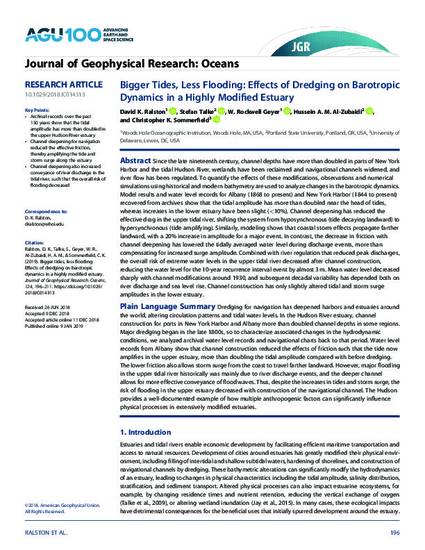
Article
Bigger Tides, Less Flooding: Effects of Dredging on Barotropic Dynamics in a Highly Modified Estuary
Journal of Geophysical Research: Oceans
Sponsor
Funding for D. K. R., W. R. G., and C. K. S. was provided by NSF Coastal SEES awards OCE‐1325136 and OCE‐1325102. Funding for S.T. and H. Z. was provided by the U.S. Army Corps of Engineers (award W1927 N‐14‐2‐0015), and NSF (Career Award 1455350). Data supporting this study are posted to Zenodo (https://doi.org/10.5281/zenodo.1298636).
Document Type
Article
Publication Date
1-1-2019
Subjects
- Water levels,
- Barotropic Tides,
- Flood Frequency,
- Dredging
Disciplines
Abstract
Since the late nineteenth century, channel depths have more than doubled in parts of New York Harbor and the tidal Hudson River, wetlands have been reclaimed and navigational channels widened, and river flow has been regulated. To quantify the effects of these modifications, observations and numerical simulations using historical and modern bathymetry are used to analyze changes in the barotropic dynamics. Model results and water level records for Albany (1868 to present) and New York Harbor (1844 to present) recovered from archives show that the tidal amplitude has more than doubled near the head of tides, whereas increases in the lower estuary have been slight (
Locate the Document
DOI
10.1029/2018JC014313
Persistent Identifier
https://archives.pdx.edu/ds/psu/28826
Citation Information
Ralston, D. K., Talke, S., Geyer, W. R., Al‐Zubaidi, H. A., & Sommerfield, C. K. (2019). Bigger Tides, Less Flooding: Effects of Dredging on Barotropic Dynamics in a Highly Modified Estuary. Journal of Geophysical Research: Oceans, 124(1), 196-211.

© 2019 American Geophysical Union